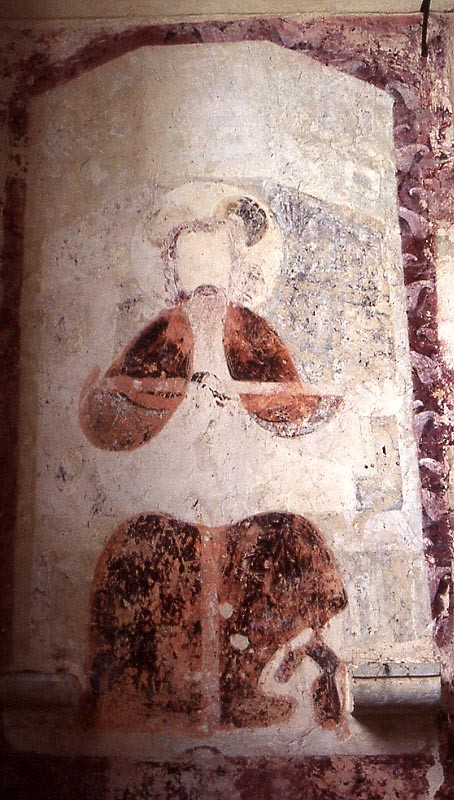Boughton Aluph, Kent (†Canterbury) C.15
Trinity

Although the doctrine of the Trinity dates back at least to St Augustine and before that to Matthew 28:19, it is rare in art before the early Renaissance. Masaccio’s famous perspective-mastering example in Santa Maria Novella, Florence (c.1428) is probably the best-known example of the standard iconography.
Carved alabaster images of the Trinity in this form, with God the Father supporting the Cross with the Crucified Christ while the Dove of the Holy Spirit hovers above, became popular in England in the later 15th century; most came from the centres of alabaster production near Nottingham, and many were exported to mainland Europe.
Paintings, though, are very few and far between. The recently-discovered Judgement at Houghton-on-the-Hill in Norfolk may turn out to include a Trinity, but one recorded at Winterbourne Earls in Wiltshire was lost at the demolition of the church in the late 19th century.
Only the arms and part of the head of Christ on the Cross are really visible now in the Boughton Aluph example, and the Dove representing the Holy Spirit has gone altogether, along with most of God the Father’s facial features. The Father’s four-lobed halo is typical of later 15th century painting, but I cannot identify whatever was once in the oddly-shaped whitish area where something was once superimposed on the lower part of God’s red robe at the right. A tiny donor-figure is one possibility.
Also puzzling are the suggestions of painted frames – at least two, possibly three – here. The purple-red frame with a stylised solid scrollwork design has some stylistic similarities to that around the Weighing of Souls at South Leigh in Oxfordshire, and it may belong to the Trinity. But there are traces of a much smaller frame with an arched top below, and this must once have have surrounded some other, earlier subject. The larger arched white area, extending above well beyond God’s head (to give space for the Dove), overlaps the design on the reddish frame, and seems to belong neither to the painting we have nor to the smaller design in the earlier frame. To add to the confusion, the Trinity was lucky to escape destruction by a fire in the church at sometime in the past, and the yellow tinge of the plaster on the left-hand side might result from damage done then.